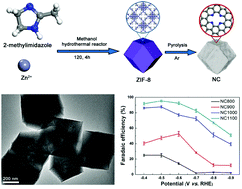MOF-derived nitrogen-doped nanoporous carbon for electroreduction of CO2 to CO: the calcining temperature effect and the mechanism†
Abstract
Nitrogen-doped carbon materials are promising electrocatalysts for electroreduction of CO2. However, the low current density and moderate faradaic efficiency of these materials limit their practical application. Here, we report the MOF-derived nitrogen-doped nanoporous carbon (NC) as a highly efficient and stable electrocatalyst for the conversion of CO2 to CO. The NC catalysts were prepared by calcining ZIF-8 at different temperatures in argon (Ar). The catalytic performances show that the higher pyrolysis temperature result in a better CO2 electroreduction activity of the catalysts. The NC catalyst with the best performance achieves high selectivity with 95.4% CO faradaic efficiency (FE) at −0.5 V vs. reversible hydrogen electrode (RHE). The catalyst also maintains long-term stability of 20 h operation, after which the FE of CO is still greater than 90%. The experiments show that higher pyrolysis temperature reduces the total nitrogen (N) but changes the nature and density of N defects. Density functional theory calculations reveal that higher pyrolysis temperature leads to enhanced activity by promoting the formation of low multiple pyridinic N, which provides more efficient active sites.

- This article is part of the themed collection: Research selection from the NCNST


 Please wait while we load your content...
Please wait while we load your content...